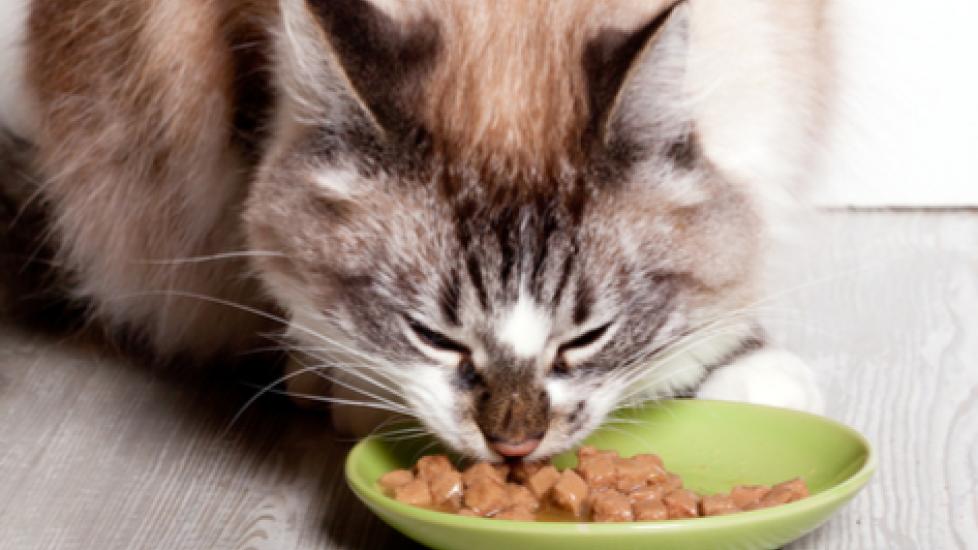Best Food for Cats with Diabetes
By Jennifer Coates, DVM
Diabetes is reaching epidemic proportions—not just in people but also in cats. Most cases of feline diabetes are similar to what is called Type 2 diabetes in people, which means that weight management and diet are major factors in the development and control of the disease. Read on to learn everything you need to know about how to pick the best food for a cat with diabetes.
The Basics of Feline Diabetes
Understanding how diet plays a role in the management of diabetes requires some basic information regarding the relationship between food, blood sugar levels, and the hormone insulin.
Insulin is produced by special cells in the pancreas. It is secreted into the bloodstream when blood sugar levels rise, for instance after a meal. Insulin allows sugar to enter cells where it is used to fuel biological processes or converted into other substances and stored for later use. When cats have Type 2 diabetes, their cells no longer adequately respond to insulin leading to chronically high blood sugar levels. The pancreas reacts by producing more insulin, but eventually the organ essentially wears out, and the cat will need insulin injections to survive.
The Role of Obesity in Diabetes
One of the most important factors that leads to diabetes in cats is obesity. Fat cells produce hormones that make the body less responsive to insulin. The more fat that is present, the more of these hormones that are produced.
Many cases of feline diabetes could be prevented if cats were not overfed and they remained slim. Weight loss can even lead to remission in a cat’s diabetes if treatment begins early in the course of the disease. In other words, diabetic cats who initially need insulin injections may be able to be weaned off of them if they lose sufficient amounts of weight.
The Best Food for Diabetic Cats
No single type of food is the right choice for all diabetic cats, but there are some guidelines that are usually followed.
- Low carbohydrates/high protein: Eating carbohydrate-rich meals leads to sudden spikes in blood sugar levels, which increases a cat’s demand for insulin. This is the exact opposite of what a diabetic cat needs. Low carbohydrate foods blunt this response. Cats should get most of their calories from animal-based sources of protein. Fat is needed to round out the diet but high levels can be problematic if a cat needs to lose weight. Look for foods with around 50 percent of their calories coming from protein and 40 percent coming from fat. Many diabetic cats do well on foods that are less than 10 percent carbohydrate, but some may need to go below 5 percent. Carbohydrate levels are not often listed on pet food labels, but they are relatively easy to calculate.
- Canned is best: A large amount of carbohydrate is a necessary component to kibble. Therefore, dry foods simply can’t be made with the low carbohydrate concentrations that most diabetic cats need. Some canned foods, on the other hand, contain no carbohydrates at all.
- Over-the-counter versus prescription: Many over-the-counter, canned foods have the low carbohydrate/high-protein profile that is appropriate for diabetic cats, so a prescription diet is usually not necessary. If your cat simply won’t eat canned food and you find it necessary to feed kibble, dry foods with lower than average carbohydrate levels that are designed specifically to help with diabetic control are available through veterinarians.
- Watch portion sizes: The quantity of food that a diabetic cat eats is just as important as the type of food you offer. Obese cats should eat an amount that encourages a healthy rate of weight loss. A goal of around 1 percent of body weight per week is appropriate for most cats until they have reached their ideal body condition. Weight loss can be achieved by feeding a reduced amount of a diabetes-friendly food. Over-the-counter weight loss diets tend to be too high in carbohydrates for diabetic cats.
- Palatability matters: Because diabetic cats should eat on a set schedule, it is important that their food tastes good and they look forward to mealtimes. Thankfully, many canned cat foods are both tasty and appropriate for diabetics, so finding one that your cat likes shouldn’t be too difficult.
How to Feed Diabetic Cats
Consistency is key when it comes to feeding diabetic cats, particularly if they are on insulin. Cats should eat the same amount of food at the same time each day. Most diabetic cats receive two daily insulin injections that are given 12 hours apart. Ideally, food should be offered just before the next dose of insulin is due. That way, if a cat does not eat a full meal, the amount of insulin can be reduced. Your veterinarian will put together a detailed plan regarding when and how to adjust insulin dosages. If in doubt, do not give your cat any insulin and call your veterinarian for advice.
Treats should be limited to 10 percent of a diabetic cat’s diet and given at the same time every day. Good options like freeze-dried chicken, beef, salmon, tuna, and liver are high in protein and low in carbohydrates, just like the foods recommended for diabetic cats. Stop giving treats if they interfere with your cat’s appetite at regular mealtimes.
Finally, never make any changes to your diabetic cat’s insulin dose or diet without first talking to your veterinarian. Diabetes management is a delicate balance between diet and insulin levels. Changing one almost invariably necessitates a change in the other to keep cats safe from potentially fatal fluctuations in their blood sugar levels.
